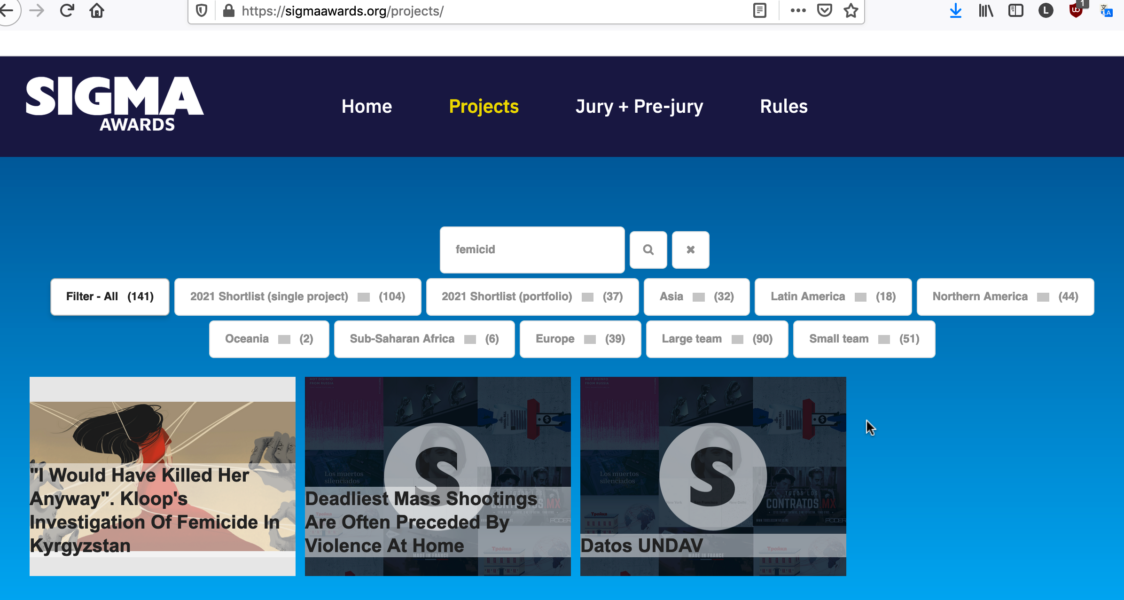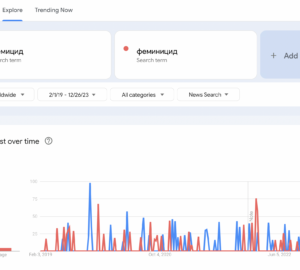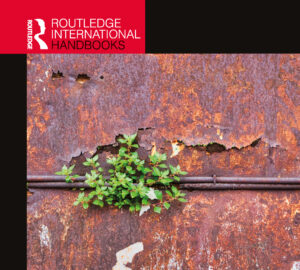Московский женский музей и femicid.net поздравляют кыргызский антифемицидный проект с профессиональным и интернациональным признанием! Это огромное достижение для всех, кто работает против фемицида в мире, потому что фемицид — не локальная проблема, ее не возможно решить ни в одной стране, пока у женщин не будет права на жизнь во всех странах.
Anna Kapushenko сейчас ![]() полна надежд. 8 мая 2021
полна надежд. 8 мая 2021
Savia Hasanova 8 мая 2021 года
2021 Shortlist
“I would have killed her anyway”. Kloop’s investigation of femicide in Kyrgyzstan
Country/area: Kyrgyzstan
Organisation: https://kloop.kg/
Organisation size: Small
Publication date: 17 Dec 2020
Credit: Savia Hasanova, Anna Kapushenko, Alina Pechenkina, Edil Baiyzbekov, Almir Almambetov, Kairat Zamirbekov, Aziza Raimberdieva
Project description:
Our project investigates femicide in Kyrgyzstan. Its uniqueness is that before us nobody has ever conducted any studies on women’s murders, what are the patterns of those murders and what are the grounds behind femicide in the country. Using the data we collected from various sources, we proved that women’s killings are the primary consequence of systematic domestic violence. Women are rarely being murdered outside their home, and the majority of murderers are their intimate partners. Our project tells the stories of women, provides an open-source database of femicides available for download and describes the policy response from the state.
Impact reached:
Our project is not just the data-journalism project, but a complete comprehensive research. The impact of it includes:
- We, first of all, introduced the term “femicide” into the media space not just in Kyrgyzstan, but in Central Asia. Before our research was presented, the mass-media was predominantly covering the cases of domestic violence, rarely paying attention to femicide itself. Not just mass-media, but also NGO and research institutes, whose focus is gender equality, have systematically studied the problem of femicide. The data on women’s murders was not publicly opened, even the number of such murders was hidden from the public.
- The project has resonated both in Kyrgyzstan and other Central Asian countries. It had received solid media coverage, it was presented in a number of round tables on domestic violence and it was highlighted by the UNWomen Kyrgyzstan, Soros Foundation and a number of feminist organizations.
- We have disseminated our findings among several members of parliament and governmental bodies, however, as the project was published in late December 2020, we have not been able to receive any reaction yet.
- We have published our research findings as a separate study (in Russian and Kyrgyz languages), and as a longread in online media outlet kloop.kg (in three languages: Russian, Kyrgyz and English. Please note, that the original publication is dated December 17, 2020. Only the English translation was published later on January 28, 2021. For English translation please see “Project link 2”). The article took 47 place by the number of unique viewers, and the average time spent on the article was almost 6 minutes. This is almost six times longer than the average time for other articles. The facebook coverage was 38,000 users, which is quite unique for our media outlet.
Techniques/technologies used:
In total we spent 6 months on the project.
- We first developed the methodology, based on literature review and existing research on femicide in Georgia, Spain, Latin America etc. Generally femicide is the murder of a woman, usually committed by a man on the basis of misogyny, gender discrimination, and/or as a result of gender-based violence in which the state is complicit. So to properly define the term “femicide” we have come up with at least 12 criteria, by which a woman’s murder can be considered as femicide. For example, the “classic” femicide is murder of a woman by her husband because she was disobeying. Other criteria include murders because she refuses to consent, she was murdered with particular cruelty, she was socially-vulnerable etc.
- To understand the femicide patterns we analysed news. We have scraped more than 54,000 of news articles from the largest news agency in Kyrgyzstan. These news also contained press-releases of the law enforcement bodies.
- To narrow down our analysis we have identified around 80 words and sentences in accordance with the previously developed femicide criteria. This let us identify news and press releases that covered the women’s murders.
- We then analyse more than 3,000 of news in details to identify femicide. As a result we were able to surely define at least 300 women’s murders as femicide during the past ten years. We have created a detailed database, containing the description of each case.
- We have calculated the coefficient of femicide (number of women’s murders per 100,000 of women) to provide international comparisons. We have also studied criminal statistics to find the “hidden” femicide and to understand the dynamics of women’s murders.
Techniques: Python, Scraping, Analysis in Python and Google spreadsheets, data visualization in Flourish.studio, storytelling in Infogram.
What was the hardest part of this project?
One of the main difficulty was to analyse each murder to comply with the femicide criteria. The database was created from scratch, we had to constantly update it every time a new detail of the murder was found.
The other difficulty was that any official statistics on women’s murders is not publicly available. We were struggling with bureaucracy to send inquiries to the Ministry of the Internal Affairs, The General Prosecutor’s Office etc. and to get replies from them. The Ministry of the Internal Affairs does not want to connect domestic violence to femicide and they have completely denied our interview requests and ignored us.
It was also quite difficult to research the topic in general, because there are no experts in the country on femicide. We had to extensively search through the literature, find international experts to make sure we understand the topic and can explain it to our audience in a simple and intelligible way. The Kyrgyz society is a conservative and has a traditionalist culture, therefore anything that contains the prefix “fem” is immediately rejected.
However, we believe that we had overcome this and did our job very well.
What can others learn from this project?
We believe that our methodology is well-developed and journalists are welcome to use it for monitoring femicide in their countries. The methodology can be used by any beginner data-journalist.
We also encourage journalists to use our femicide database for writing their own stories. The database we created, contains full description of the location and date of the murder, the age of both victim and murderer, their initials, the type of a femicide, relation of the victim to the murderer, injures, type of punishment etc.
Despite the wide prevalence of femicide in the world, not every country recognizes it as a separate problem. Legislation in Central Asain countries, for example, does not distinguish murders of males and females. We however find it especially important that femicide should be introduced in legislation as a separate term, because the causes of women’s killings are completely different and are based on existing gender stereotypes and discrimination. We hope that our project can help journalists and other stakeholders to start systematically researching femicide and introduce it widely in their narratives.
We believe that telling about the problem is one of the ways to solve it.
Project links:
kloop.kg/blog/2020/12/17/ya-by-ee-vse-ravno-ubil-issledovanie-kloopa-o-femitside-v-kyrgyzstane/
kloop.kg/blog/2021/01/28/femicide-in-kyrgyzstan/


